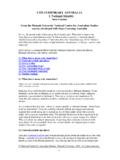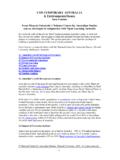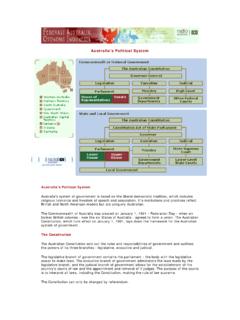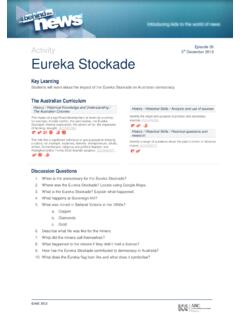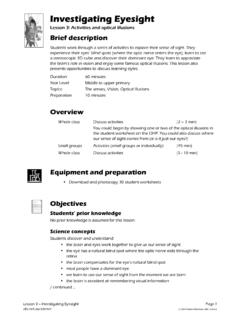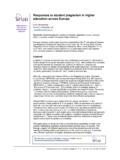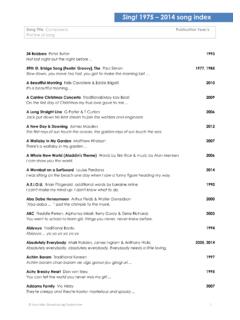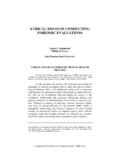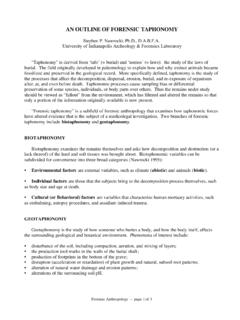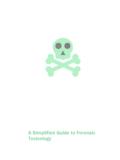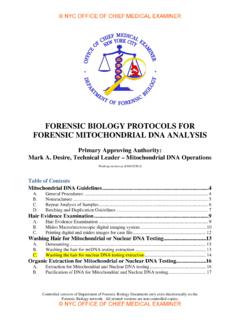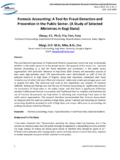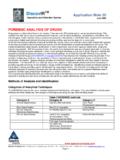Transcription of e c n e i c Sc i s n e r 3Fo - ABC
1 3 forensic Science What is forensic science? forum the market place forensic science is science applied to the administration of the law. The word forensic is derived from the Latin word forum, which means the market place . In Roman society, justice was administered in the market place. We continue to use the word forum for a public speaking place and have adopted the word forensic as the name for anything related to the administration of justice. There are many specialist fields within forensic science, such as fingerprint examination, ballistics, and blood splatter analysis. Each specialist field in forensic science is based on a common type of evidence often found at crime scenes. forensic science can be used to identify and incriminate suspects, by studying fingerprints, blood types or DNA profiles for example. It can also be used to prove or disprove claims made by suspects about an incident.
2 For example, if a suspect claims they were never at the crime scene, but unique fibres, debris, or even fungal spores turn up on the suspects clothes, possessions, or in their ear wax(!), then police can prove that the suspect is lying. The fictitious character, Sherlock Holmes, often referred to singular' objects and artefacts at crime scenes. forensic science is the key to establishing the singularity of crime scene evidence. By solving the case of Who Stole the Minister's Malibu? you will discover that evidence can take many forms, and that even simple scientific concepts play a vital role in modern forensic science. Fragmentary evidence Every contact leaves a trace .. Fragmentary evidence is any type of material left at, or taken from a crime scene, or the result of contact between two surfaces such as shoes and the floor covering or soil. The exchange of fragmentary materials between two bodies in contact is known as Locard's Principle, which states: There is no such thing as a clean contact between two objects.
3 When two bodies or objects come into contact, they mutually contaminate each other with minute fragments of material . The principle is named after Dr Edmond Locard who was a director of the technical police laboratory in Lyon, France in the early 1900s. Interestingly, Dr Locard was quite open about the inspiration he drew from the writings of Sir Arthur Conan Doyle (author of the Sherlock Holmes mysteries). Dr Locard was intrigued with the fragments of evidence which could be retrieved from dust and other trace materials found at crime scenes and suspects. In one of his articles he wrote: The microscopic debris that covers all our clothing and bodies is the mute witness sure and faithful of all our movements and all encounters.. 7 forensic science Chain of Maintaining a chain of custody Custody Name:_____. From the instant a piece of evidence is removed from a crime scene, to the time it is _____.
4 Date:_____. _____. introduced as an exhibit in a subsequent court case, its whereabouts must be able to be accounted for at all times in between. Any gap in the continuity of the timeline can render evidence useless because there is no longer any guarantee that the item was not contaminated in some way, or if it is even the same piece of evidence. When conducting the analyses, your students must sign out the evidence and record the purpose for which it is being used. They must sign the chain of custody again upon returning the evidence. This element of the competition is included to encourage students to think about the importance of maintaining accurate records, not only in the application of science in the law, but also in general laboratory science. A Chain of Custody form is provided for easy reproduction on page 36. Winning classes will be required to submit their Chain of Custody and written reports to verify information submitted at the competition website.
5 PLEASE NOTE: An express envelope will be sent to winning classes to be used to return reports and the Chain of Custody to competition judges overnight see page 30 for details. forensic laboratory guidelines One of the most important aspects of forensic science is quality assurance. To allow forensic evidence into the proceedings of a court case, a judge must be satisfied that the analyses performed were conducted to the highest possible standard and that the results are accurate and precise. forensic scientists have the profound responsibility of conducting scientific tests whose results may have severe consequences for many people (both the accused, and victims of crime). A simple error in the laboratory could have a disastrous impact on many lives, which is why forensic laboratories need to be impeccable in every aspect of their operation. They must be clean, thoroughly organised, and secure.
6 Your students should consider the risk of contaminating or confusing the evidence they received very carefully. A brief discussion may help students to identify and establish a set of behaviour guidelines for the duration of the analyses they will be performing. A wall chart to remind your students of this important aspect of forensic science is provided on page 41 of this book (you can easily enlarge it to A3 poster size, or give each student a personal copy). Who Stole the Minister's Malibu? the clues There are no red herrings' or tricks' in Who Stole the Minister's Malibu? just the evidence and the information presented in this book. With a careful approach, the results will conclusively lead you to the guilty culprit. Students build a case using the weight of evidence against the suspect most incriminated by the evidence available. None of the clues incriminates only one suspect or completely eliminates all other suspects.
7 The techniques students will use are based forensic science 8. on authentic techniques used in real forensic science laboratories all over the world. These techniques apply basic scientific concepts, presenting the teacher with many opportunities to draw links to the science curriculum. The investigations also present many opportunities for group discussions and debates on ethical issues surrounding the use of science in the justice system crime, and crime prevention. A brief description of the clues, and an example of a real case or other related factual forensic information is presented here for your interest. CLUE 1: Security Access Swipe Card & Alibis Who had the time to do it? . Establishing the time that a crime was committed is crucial in any crime investigation. It is so important to be able to accurately determine the time of an offence that there are experts whose sole job in an investigation is to determine the time of the offence.
8 For example, forensic entomology is often used to establish the time of death by careful examination of the life cycles of insects which invade corpses. In Who Stole the Minister's Malibu? a stolen security swipe card used to gain access to the Malibu was found inside the secure crime scene. The access card has a magnetic strip with three tracks which can be encoded with information. Track one is encoded with identification information particular to the staff member, track two is encoded with the time of day whenever it is used, and track three is not used (blank). Because it was left inside the secure room, the card will reveal the exact time the culprit entered the crime scene. This information can be compared to alibi statements to determine which of the suspects had time to commit the crime. PLEASE NOTE: this activity will require careful planning and consideration of the mathematical content and manipulative skills required to complete the analyses.
9 A combination of discussions led by the teacher and small group work may be most suitable in some cases (particularly for years 5 to 7). The encoding system was specifically designed for this competition it is not the same encoding system used in real swipe card access systems. Case study: The Body Farm'. Dr William Bass founded the University of Tennessee's Body Farm' in Knoxville in the late 1970s because until then little, if any scientific information on the decomposition of human corpses was available. The time of death is often the most crucial piece of evidence in murder cases, so reliable information on this sensitive issue is of paramount importance. The facility is a protected field where decomposing human corpses are studied by scientists. Dr Bass is regularly called upon by police to assist in murder investigations. This is one such case: In December 1993, "Big Mike" Rubenstein called police and told them he had found the bodies of his dead relatives in their cabin in Summit.
10 He claimed that he had visited the cabin twice in mid- and late- November looking for them, but that the cabin was empty. Dr Bass studied the decomposing corpses and using his knowledge of insect life cycles and decomposition rates, established that the time of death was mid-November, exactly when Rubenstein claimed he had visited the cabin. Inadvertently, Rubenstein had told the wrong' lie and was ultimately convicted of the murders. 9 forensic science CLUE 2: Powder specimens Whose shoes walked through the crime scene? . Suspects' shoes can yield a wealth of information about their travels. A plethora of chemical substances, dust and particles can become attached to the tread of our shoes as we traverse the myriad surfaces we come across cross in our everyday lives. And footprints found at a crime scene can help to identify a suspect, or some of their physical characteristics to narrow down suspect lists (eg shoe size, approximate weight height and gender).
